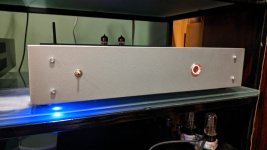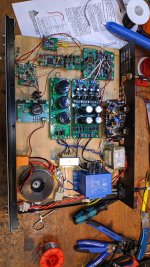Hi @tamra , for galvanic isolation:
(close the J4 jumper) https://www.diyaudio.com/community/attachments/jlondac-jpg.1002318/
(let SJ1 and SJ2 open) https://www.diyaudio.com/community/...st-tht-i2s-input-nos-r-2r.354078/post-6885783
Powering the isolated clock for I2SoverUSB can be either by +5VD from DAC pcb, or a separated +5VD PSU.
... for +5VD from DAC: short SJ3
... for a separated +5VD option let SJ3 open and insert the +5VD wire to the +5VD2 pin on the DAC pcb (GND from separated PSU connect with the closest GND pin near to the +5VD2 pin)
😉
Don't close B1, B2, B3 because I2SoverUSB in "AD1862, I2SoverUSB v.III - not flipped PCB" is configured for 20-bit PCM drive (only J4 is closed).
Propably a heatsink will be needed for the PSU regulator (I2SoverUSB is hungry). Check the temperature on the +5VD regulator during the use.
(close the J4 jumper) https://www.diyaudio.com/community/attachments/jlondac-jpg.1002318/
(let SJ1 and SJ2 open) https://www.diyaudio.com/community/...st-tht-i2s-input-nos-r-2r.354078/post-6885783
Powering the isolated clock for I2SoverUSB can be either by +5VD from DAC pcb, or a separated +5VD PSU.
... for +5VD from DAC: short SJ3
... for a separated +5VD option let SJ3 open and insert the +5VD wire to the +5VD2 pin on the DAC pcb (GND from separated PSU connect with the closest GND pin near to the +5VD2 pin)
😉
Don't close B1, B2, B3 because I2SoverUSB in "AD1862, I2SoverUSB v.III - not flipped PCB" is configured for 20-bit PCM drive (only J4 is closed).
Propably a heatsink will be needed for the PSU regulator (I2SoverUSB is hungry). Check the temperature on the +5VD regulator during the use.
Thanks iggy@intojazz,
You can make a low noise adjustable reg with from a LM317 for example.
Theorically, the 5V of the pin 17 on the JLSounds board must be very low noise and ripple rejection as they feed the nice clock made of two nice NDK SA.
In that regard the TS7A reg Jimk04 uses in spite of 7805 is a nice swap. More expensive on a rabbit hole deepness point of view.... but still cheap VS the tons of bad off the shelves delta sigma dacs.
Imho miro's board even doesn't need reconstruction filter... but one rule: trust your ears, the final rendering is always the sum of all your hifi equipments. 🙂
Contact Paddy for genuine dac chips:
https://www.diyaudio.com/community/threads/new-unused-ad1862n-and-ad1865n-j-dac-chips.368012/
https://www.diyaudio.com/community/threads/new-unused-ad1862n-and-ad1865n-j-dac-chips.368012/
Thanks!Contact Paddy for genuine dac chips:
https://www.diyaudio.com/community/threads/new-unused-ad1862n-and-ad1865n-j-dac-chips.368012/
Be careful interfacing fast, modern ICs with slow, antiques. The AD1862 expects the data input to be settled and stable for 15ns preceding and following the rising edge of the clock. (see figure 12b in the datasheet) The typical 3.4ns propagation time of the AHCT164 means the AD1862's input requirements will not be met. Is that a problem?I used 74AHCT164D (faster) instead of 74HCT164D , is there any problem?
With the 74AHCT164 data will be prepared slightly faster as with the 74HCT164. In this case it doesn't touch the AD1862 requirements 😉
My reference for a good while now has been an SD card player>>Mori clocks>>Miro DAC>>3a5 DHT output stage.... and I have been using a duplicate setup with many different output stages - from opamps, to solid state, to valve. However I think I am not at the end of that rope, and I will use the second build for a USB front end. I have this almost finished now, just waiting on a USB panel mount cable for it. Along the way, I added a bluetooth module and 12s switch to allow me to flip between USB and bluetooth. I've used a 6922 DC coupled cathode follower for the output stage. Very happy with this build which seems rock solid.
This Miro dac has been a real road of travel for me over the past year or so. I had come from a very good 1794 DAC, which is still great, but the AD1862 just tips it as the winner. I know I've said it before, but we should be very grateful for the community here that has fostered this - Miro of course, but also Paddy Garcia for the chips, EUVL for much advice and experience with output stages, and many, many more who have contributed along the way with feedback and testing.
Happy New Year, and may all your builds in 2022 be easy and free of hum!
This Miro dac has been a real road of travel for me over the past year or so. I had come from a very good 1794 DAC, which is still great, but the AD1862 just tips it as the winner. I know I've said it before, but we should be very grateful for the community here that has fostered this - Miro of course, but also Paddy Garcia for the chips, EUVL for much advice and experience with output stages, and many, many more who have contributed along the way with feedback and testing.
Happy New Year, and may all your builds in 2022 be easy and free of hum!
Attachments
Very cool diy....
Your tube kit avoids dc blocking cap or output traffo ?
Is it good to mix left and right output wire till the rcas ? Or you use only one gnd wire for both rca to avoid a ground loop ?
Your tube kit avoids dc blocking cap or output traffo ?
Is it good to mix left and right output wire till the rcas ? Or you use only one gnd wire for both rca to avoid a ground loop ?
Nah, there's a cap on each channel out - I tend to favour Bennic caps for this, but have used some of the Russian ones before to excellent. They really have great capacitors.
There's one ground wire between channels - they are tied together on the PCB anyway, but also the two RCA jacks grounds are tied together and then a single wire back to the board. Twisting the wires is habit more than anything else - it's just neater and without it, I always end up with a much worse rats nest (and its already a bit like that!). I try to keep i2s lines as short as possible too. The i2s from the bluetooth unit is a bit long, but thats really for casual listening. The USB amanero links directly to the reclock, then i2s switch before the DAC. I usually would reclock just before the DAC, but I can't do that here with no mck from the bluetooth.
That little cathode follower board is from Aliexpress, I replaced the plate resistor on the gain triode and cathode resistor on the follower with CCS (just 10m45s) which definitely helps it. heaters are AC, with a virtual centre tap elevated off ground by 75V. Even without the elevation, I was still within cathode to heater limits, but the advice out there is that elevating the heaters often makes the stage a bit quieter. So, last step (is it ever a last step!) I think is to get that panel mount USB cable and run it to the back wall, and put the lid on it.
While the USB/amanero with Mori clocks is clearly better than bluetooth, I can say that the bluetooth really does sound good. If you heard this and didn't hear USB you'd think it was great. Very handy for running streaming to hear new material.
There's one ground wire between channels - they are tied together on the PCB anyway, but also the two RCA jacks grounds are tied together and then a single wire back to the board. Twisting the wires is habit more than anything else - it's just neater and without it, I always end up with a much worse rats nest (and its already a bit like that!). I try to keep i2s lines as short as possible too. The i2s from the bluetooth unit is a bit long, but thats really for casual listening. The USB amanero links directly to the reclock, then i2s switch before the DAC. I usually would reclock just before the DAC, but I can't do that here with no mck from the bluetooth.
That little cathode follower board is from Aliexpress, I replaced the plate resistor on the gain triode and cathode resistor on the follower with CCS (just 10m45s) which definitely helps it. heaters are AC, with a virtual centre tap elevated off ground by 75V. Even without the elevation, I was still within cathode to heater limits, but the advice out there is that elevating the heaters often makes the stage a bit quieter. So, last step (is it ever a last step!) I think is to get that panel mount USB cable and run it to the back wall, and put the lid on it.
While the USB/amanero with Mori clocks is clearly better than bluetooth, I can say that the bluetooth really does sound good. If you heard this and didn't hear USB you'd think it was great. Very handy for running streaming to hear new material.
Really nice,
I’d like to add Bluetooth connectivity to a more basic version of Miro’s dac. Could you please comment on what module you used? Bluetooth is excellent for hearing new material from several genres
Thanks
I’d like to add Bluetooth connectivity to a more basic version of Miro’s dac. Could you please comment on what module you used? Bluetooth is excellent for hearing new material from several genres
Thanks
Last edited:
Sure - the module I used was picked up on the swap meet here, but its the same as this one:
https://www.aliexpress.com/item/4000245658357.html?spm=a2g0o.cart.0.0.617b3c00puz7bb&mp=1
3.3V supply, LRCK, BCK and Data output. There are options for volume up and down etc as well as is usual for these boards. I see the same one for same on audiophonics for a little more with the comment that they say it has a good reputation for sound quality. There is also a version that has a u.fl connector that is probably a better job than the SMA connector as you will likely want to run it to an antenna outside the case. I had patchy enough sound until I added the antenna.
The i2s switch I used was this one, but there are 4 way ones out there too. If you line it all up right, you can have very short connections between the inputs - I can't say I've noticed a sound quality difference between using such devices and not, but I don't think there is.
As always with aliexpress, pick a shop that has feedback, shipping time is reasonable etc.
Fran
https://www.aliexpress.com/item/4000245658357.html?spm=a2g0o.cart.0.0.617b3c00puz7bb&mp=1
3.3V supply, LRCK, BCK and Data output. There are options for volume up and down etc as well as is usual for these boards. I see the same one for same on audiophonics for a little more with the comment that they say it has a good reputation for sound quality. There is also a version that has a u.fl connector that is probably a better job than the SMA connector as you will likely want to run it to an antenna outside the case. I had patchy enough sound until I added the antenna.
The i2s switch I used was this one, but there are 4 way ones out there too. If you line it all up right, you can have very short connections between the inputs - I can't say I've noticed a sound quality difference between using such devices and not, but I don't think there is.
As always with aliexpress, pick a shop that has feedback, shipping time is reasonable etc.
Fran
- Home
- Source & Line
- Digital Line Level
- DAC AD1862: Almost THT, I2S input, NOS, R-2R


